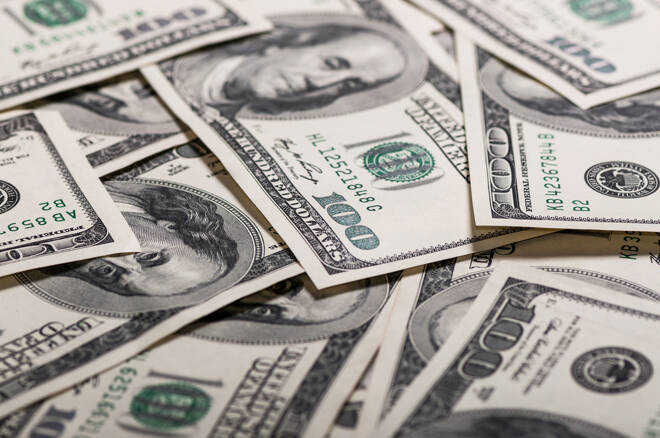Advertisement
Advertisement
U.S. Dollar Tumbles as Investors Weigh Impact of Hurricane Irma on Economy
By:
The U.S. Dollar continued to slide on Friday, hitting a more than 2-1/2 year low against a basket of major currencies on falling expectations of another
The U.S. Dollar continued to slide on Friday, hitting a more than 2-1/2 year low against a basket of major currencies on falling expectations of another U.S. Federal Reserve rate hike this year. In the meantime, the Euro, which represents 57% of the U.S. Dollar Index, rallied to another multi-year high in the wake of the European Central Bank’s interest rate and monetary policy decisions.
The one of the market was bearish on Friday with investors raising concerns over the impending short-term impact of Hurricane Irma on the U.S. economy. The hurricane is expected to hit the state of Florida over the week-end and it is expected to be devastating for the economy as well as the landscape.
Friday’s price action indicates investors are trying to price out any potential Fed rate hike for the remainder of the year. This was especially seen in the dollar’s drop against the Japanese Yen. It fell to a 10-month low at 107.33 before settling at 107.837, down 0.620 or -0.57%. For the week, the USD/JPY lost 2.18%.
The EUR/USD finished the week at 1.2034, up 1.46%, putting it up more than 14 percent this year. The price action indicated that investors had shrugged off ECB President Mario Draghi’s dovish comments on Thursday. Traders said the single currency was also supported by a Reuters report which said central bank officials were in broad agreement that their next step would be to reduce their bond purchases.
Some say a buying frenzy may have been ignited by the ECB because of its lack of clarity regarding the timing of its plan to begin tapering.
U.S. Economic Reports
On Friday, minor reports included Final Wholesale Inventories which came in bearish at 0.6%. Investors were looking for a reading of 0.4%. Consumer Credit was 18.5 billion, up from 11.8 billion. The estimate was 15.1 billion.
Hawkish FOMC Member and Philadelphia Federal Reserve President Patrick Harker gave a speech on Friday, but offered no comment on the economy or policy. Nonetheless, investors continued to react to Thursday’s some-what dovish comments from New York Fed President William Dudley. During a speech, he said that the central bank should continue gradually raising U.S. interest rates, but sounded slightly less confident than in his previous hawkish comments.
Gold
Dollar-denominated gold moved to its highest price in more than a year on Friday after the U.S. Dollar fell to a 2-1/2 low against a basket of currencies. This made gold more attractive to foreign investors.
Gold was also supported by a decline in U.S. bond yields, which held near 10-month lows. The market was underpinned as investors continued to digest the comments made by the ECB, after it decided to leave its benchmark interest rate unchanged at its September meeting on Thursday.
ECB President Draghi said he was confident the Euro Zone’s inflation will move towards the bank’s target but warned that downside risks remained.
Gold traders were also keeping an eye on political and geopolitical events. In Washington, the key story is talk of a short-term extension of the debt ceiling and government funding plan. Internationally, investors are paying close attention to North Korea. There are rumors the rogue nation will test another nuclear weapon this week-end.
Crude Oil
Profit-taking and concerns over future demand for crude oil helped drive down U.S. West Texas Intermediate crude oil and international-benchmark Brent crude oil.
U.S. crude oil futures tumbled last week as a result of low refining activity following Hurricane Harvey, which sharply reduced demand for crude oil. Harvey’s impact hurt U.S. oil production the week-ending September 1. According to the U.S. Energy Information Administration (EIA), U.S. output fell by almost 8 percent, from 9.5 million barrels per day (bpd) to 8.8 million bpd.
This week, WTI crude rose 0.40% and Brent crude rose 1.50% after refineries began to rev up activity. Most refineries are restarting and the market expects a near-full recovery by the end-of-September. Brent also found some support from news that Saudi Arabia will cut crude oil allocations to its customers worldwide in October by 350,000 barrels per day (bpd).
Crude oil was also pressured by concerns over Hurricane Irma which is on track to hit Florida this week-end. The damage could be devastating to the economy. Florida is a driving state, so we could see a decline in demand for gasoline and crude oil due to home and infrastructure damage.
About the Author
James Hyerczykauthor
James Hyerczyk is a U.S. based seasoned technical analyst and educator with over 40 years of experience in market analysis and trading, specializing in chart patterns and price movement. He is the author of two books on technical analysis and has a background in both futures and stock markets.
Advertisement
